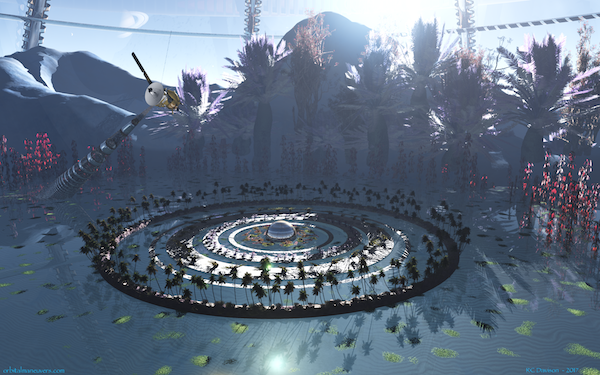Cassini’s Garden was originally created to commemorate the amazing probe that has been in space for almost 20 years and orbiting Saturn and collecting data since 2004. But, it’s not just the machine, it’s the international group of people that worked together to make the mission happen.
Originally known as Cassini-Huygens, which identifies the Huygens lander that was carried onboard Cassini and successfully touched down on Saturn’s largest moon, Titan, on January 14, 2005. Huygens was provided by the European Space Agency (ESA) and along with the Italian space agency, Agenzia Spaziale Italiana (ASI) and NASA formed the three partners for the mission. In total there were 17 countries involved in the mission. In all, over five thousand people have touched this mission since its development began in 1990; from engineers, technicians, designers, machinists, scientists, astronomers and a host of other specialists from around the world.
The Cassini mission has exemplified the best of what we can do when we cooperate together; something that is painfully lacking around the world today when it is needed most. The data produced by this mission is available to everyone – everybody on this planet benefits from the international cooperation that gave birth to Cassini-Huygens.
Cassini’s Garden shows a monument to the enduring probe that has been erected on Enceladus sometime in the future when we humans are no longer defined by our differences.
The probe has had a few problems during its tour but nothing that has diminished its mission nor prevented it from being extended two more times after its initial 4 year jaunt. The only thing that has forced Cassini to end its mission now is that it is running out of fuel, and to prevent it from potentially contaminating Titan or Enceladus with microbes from Earth, it will be directed to fly into Saturn on September 15, 2017. Truly a sad day for everyone involved with this noble machine or that have followed its mission over the years.
And, speaking of potential for life, a paper has recently been published discussing the data Cassini has collected from a fly-through of the plums of water ice and gas venting from the small moon Enceladus’ southern pole in October of 2015. This data revealed the presence of molecular hydrogen (H2) in the gas/ice cloud, which was mostly water. The presence of hydrogen indicates that there may be hydrothermal vents on the ocean floor of Enceladus. A chemical reaction between the water and the rocks on the ocean floor, driven by the heat could create the hydrogen. This in turn could be used by bacteria as a food source when combined with carbon dioxide dissolved in the water.
The H2 is not direct evidence of life, but compelling evidence that all the right ingredients are there to support life – probably bacterial – like we see around the hydrothermal vents in our oceans. One more feather in Cassini’s cap! Check out NASA’s website for more information on this.
With Cassini setting up to dive between the planet and its inner rings later this month as a finale to its mission, we can expect to see some really amazing images and learn more about this majestic ringed planet than ever before. And, as the data is processed and digested we can expect more revelations about this planet in the years to come.
Thank you to the Cassini team for all their hard work and an amazing ride!
For more information check out Cassini’s Grand Finale.
Till next time,
RC Davison


